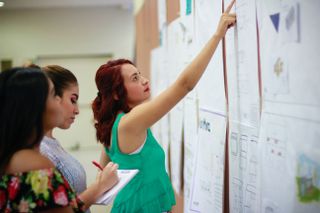Professional learning communities (PLCs) can increase teacher morale and retention. This helps create a positive school culture focused on growth, which also has a beneficial impact on student achievement.
Daniel Guerrero, vice president of Learning Design at BetterLesson, and Stefani Morrow, Learning Designer for Instructional Leadership at BetterLesson, share tips for creating and fostering effective PLCs within any school or district.
What is a PLC?
PLCs are teams of educators who share ideas to enhance their teaching practice and help their students improve as a result. These teams can operate inside a single school or across a district.
“I like to think of the professional learning community as a classroom for teachers, or it's a place where teachers go to learn,” Morrow says.
“PLCs are about really being able to build a community-driven response and approach to learning,” Guerrero says. “And with that comes a lot more empowerment, a lot more authenticity, that sometimes can be missing from professional learning.”
What Role Can PLCs Play in Building Teacher Morale and Increasing Staff Retention?
PLCs can foster the sense of connectivity and success that keeps teachers enthusiastic about their role, advocates say.
“When we think about students who drop out of school or that kind of thing, a lot of times, it's because they're struggling, and they don't have the support that they need, or they don't have the proper scaffolds, and I think the same is true for teachers,” Morrow says.
Engaging with peers while learning and improving their craft can help teachers gain confidence and enhance their enjoyment in teaching, she adds.
How Can PLCs Foster Innovation?
PLCs inherently meet teachers where they are, more so than traditional professional development, and can therefore more directly influence pedagogy. “If you're sitting in the auditorium [for professional development] the day before school starts, that's not the place that your practice is going to change,” Guerrero says. “Your practice is going to change when you just came from your class, and you're talking to your peers, and you're naming the same challenges, and you're hearing what they do to support it. And then maybe your coach or an instructional leader at the school says, 'Well, there's this research-backed strategy. Let's talk about that.'”
Morrow says PLCs can help educators ensure they’re making the most of these casual conversations and observations. “The PLC structure provides a cycle where those kinds of watercooler conversations around challenges can be addressed in a consistent way,” she says.
What Does a Successful PLC Look Like?
A successful PLC is aligned with larger school and district goals, and will incorporate data into practices and discussion. “You hear multiple voices being able to engage and you actually have a community of practice,” Guerrero says. “You don't just have one person who's sharing what they do and it isn't really a PLC, it's actually just a PD.”
To assess a PLC’s effectiveness, Guerrero would also want to know if the PLC was doing what he and Morrow call “bending the line,” which means circling back to keep discussing the same topics and challenges rather than moving on to new ones without follow-up.
“You wouldn't know if it's successful if you only showed up once. You would have to show up a couple of times in a row,” he says. “Linear PLCs are just going to kind of keep going out into the stratosphere, but [we want to see them] bending that line and turning it into a cycle where we come back and we talk about those same topics over and over."

